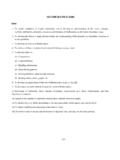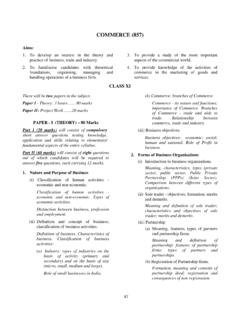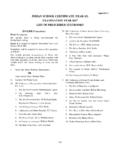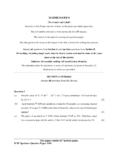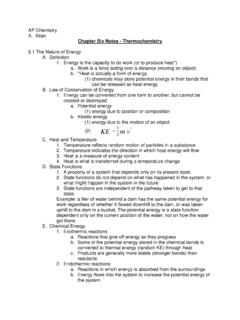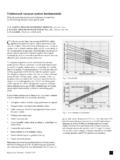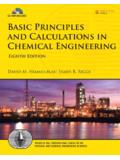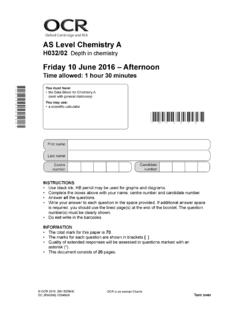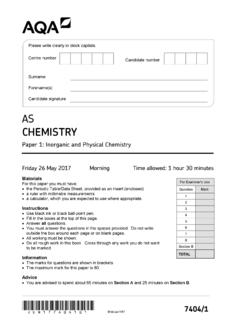Transcription of CHEMISTRY (8 62) - cisce.org
1 167 CHEMISTRY (862) foster acquisition of knowledge and understanding of terms, concepts, facts, processes, techniques andprinciples relating to the subject of develop the ability to apply the knowledge of contents and principles of CHEMISTRY in new or develop skills in proper handling of apparatus and develop an ability to appreciate achievements in the field of CHEMISTRY and its role in nature and develop an interest in activitiesinvolving usageof the knowledge of develop a scientific attitude through the study of Physical acquaint students with the emerging frontiers and interdisciplinary
2 Aspects of the develop skills relevant to the apprise students with interface of CHEMISTRY with other disciplines of Science, such as, Physics, Biology,Geology, Engineering, XIThere will be two papers in the I:Theory-3 70 marksPaper II:Practical-3 hours ..15marksProjectWork ..10marksPractical File ..5marksPAPER 1-THEORY: 70 MarksThere will be no overall choice in the paper. Candidates will be required to answerallquestions. Internalchoice will be availablein two questions of 2 marks each, two questions of 3 marks each and all the threequestions of 5 marks Basic Concepts ofChemistryPhysical Chemistry32 of Elements and Periodicity Bonding and of Matter: Gases Chemistry15 CHEMISTRY : Some basic Principles andTechniquesOrganic Chemistry23 Marks168 PAPER I THEORY 70 Basic Concepts of ChemistryGeneral introduction: Importance and scope ofmatter.
3 'satomictheory:conceptofelements,atoms (atomic)and molecular masses, moleconcept and molar mass, percentagecomposition,empiricalandmolecu larformula. Stoichiometryandcalculationsbasedonchemi cal reactions.(i)Precision andaccuracy:Quantities and their measurements inChemistry,significant figures, SIunits.(ii)Dimensionalanalysis:Conversi on of units,numericals andapplications of units.(iii)The concept of atoms having fixed propertiesin explaining the laws of about atoms.
4 Dalton s atomic theory:Main postulates of the theory; its of chemical combinations: Law of conservation of mass. Law of definite proportions. Law of multiple proportions. Law of reciprocal proportions. GayLussac s law of gaseous , explanation and simple problemsbased on these laws.(iv)Atomic(isotopic masses) molecular mass and mole:The atomic mass unit is one of theexperimentally determined unit. It is equal to1/12 of the mass of the carbon 12 problems based onmole concept,Avogadro s number andgrammolecularvolume.
5 (v)Empiricalandmolecularformula:Numerica ls based on the above.(vi)Chemical equivalents, volumetric calculationsin terms of normality. C = should betaken as a standard for expressing weight expressingthe combiningcapacity of the elements with the standardelements such as H, Cl, O, Ag, equivalent weight. Gram equivalentweights, relationship between gramequivalent weight, gram of equivalent weight of acids,alkalis, salts, oxidising and reducing agents.(experimental details not required).
6 Terms used in volumetric calculations suchas percentage (w/w and w/v), normality,molarity, molality, mole fraction, etc. shouldbe discussed. Students are requiredto knowthe formulaeandnormality and calculations on the above topics.(vii)Chemicalreactions stoichiometriccalculations based on mass-mass,mass-volume,volume-volume relationshipsand limiting ofAtomDiscoveryoffundamental particleselectron,protonandneutron),atom icnumber, 'smodel and itslimitations. Rutherford'sexperimentalmodeland its limitations.
7 Dual nature of matter 'satomicmodel and itslimitations(de Broglie'sequation,Heisenberg suncertaintyprinciple),concept of shells,subshells, ,shapesofs,panddorbitals. Rulesforfillingelectronsinorbitals-aufba uprinciple,Pauli'sexclusionprincipleandH und'sruleof maximum ,stabilityofhalf-filledandcompletelyfill edorbitals.(i)Subatomicparticles (electrons, protons andneutrons)their charges and masses:Conceptof indivisibilityof atom as proposed byDalton does not exist. The atom consists ofsubatomic fundamental particles.
8 Productionof cathode rays and their ofanode rays and s experiment for the discovery ofneutron and properties of (ii)Rutherford s nuclear model based on thescattering experiment:Rutherford sscattering of s nuclear model of atom. Defectsof Rutherford and itslimitations (Black bodyradiation and photoelectric effect)Planck s quantum based on the above.(iii)Types ofspectra:emission and line spectra to bediscussed.(iv)Bohr s atomic of Bohr s theory based onPlanck s quantum of Bohr s atomic model andexplanation ofhydrogen based on Rydberg s on Bohr s atomic radii, velocityand energy of orbits (derivation notrequired).
9 Defectsin Bohr s Model.(v)Quantummechanical modelof anatom-asimple mathematical treatment. Quantumnumbers; shape, size and orientation of s,pand dorbitals only(no derivation).aufbauprinciple, Pauli s exclusion principle,Hund s rule of maximum configuration of elements in termsof s, p, d, f subshells. de Broglie s equation. Numericals. Heisenberg SchrodingerWaveEquation physicalsignificance of and 2. Quantum numbers types of quantumnumbers,shape, size and orientation ofthe s, p and d subshells.
10 Informationobtained in terms of distance of electronfrom the nucleus, node,nodal planesandradial probability curve, energy ofelectron, number of electrons present inan orbit andan orbital. aufbau principle, (n+l) rule. Pauli s exclusion principle. Hund s rule of maximum multiplicity. Electronic configuration of elementsandionsin terms of s, p, d, f subshellsandstability of half-filled and completelyfilled of Elements and Periodicity inPropertiesSignificance of classification;study ofMendeleev s periodic law and its limitations.



